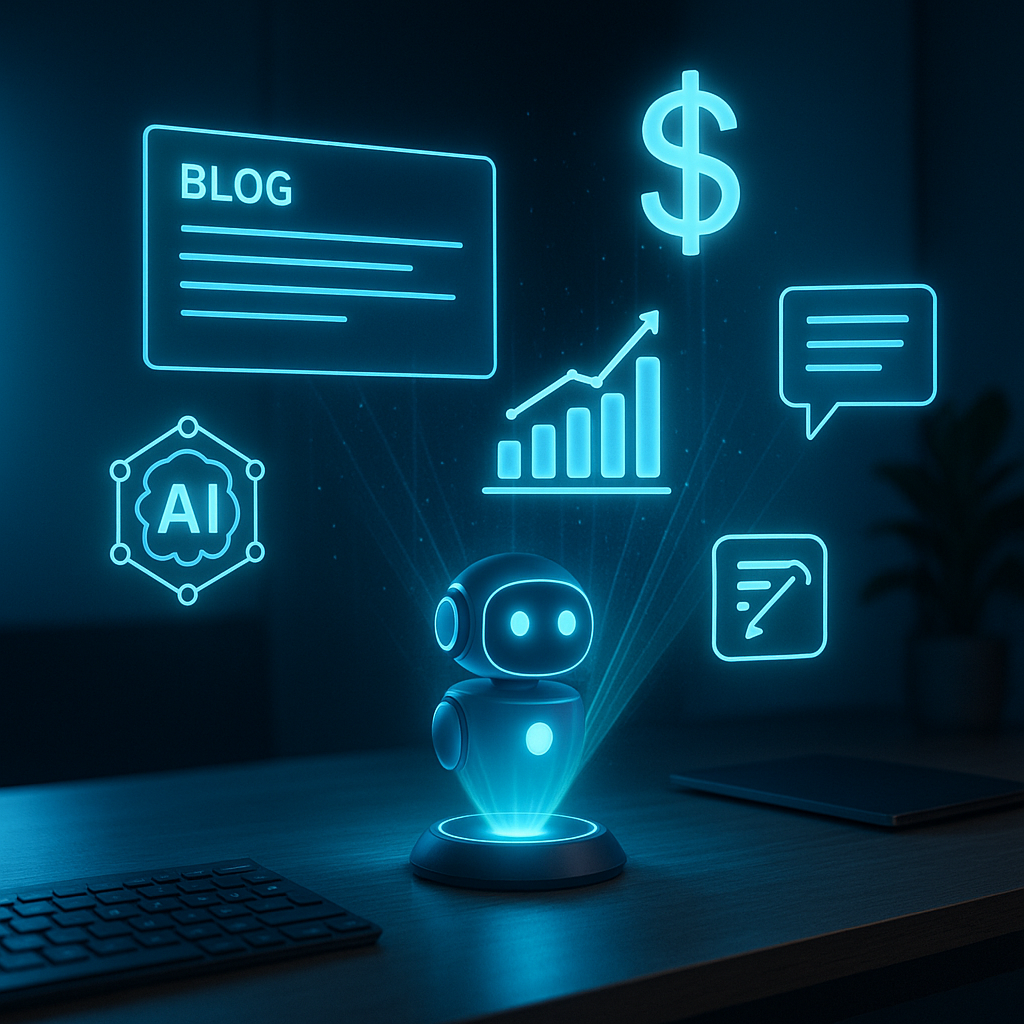Your cart is currently empty!

What’s the ROI of using AI for blog content?
•
Understanding ROI in Content Marketing
Return on Investment (ROI) is a critical metric in content marketing. It helps businesses evaluate the effectiveness of their strategies by comparing the cost of content creation to the revenue or value it generates. Traditionally, calculating ROI for blog content involves assessing traffic growth, lead generation, conversion rates, and brand visibility. But with the rise of AI-powered writing tools, the equation is shifting. AI is not just a cost-cutting tool—it’s a performance enhancer. So, what’s the ROI of using AI for blog content? Let’s break it down.
How AI Transforms Blog Content Creation
AI writing tools have revolutionized how content is produced. From ideation to final draft, AI can assist at every stage of the content lifecycle. These tools use natural language processing (NLP) and machine learning to generate coherent, relevant, and SEO-friendly content at scale. Whether you’re a solo blogger or a marketing team, AI can significantly reduce the time and effort needed to produce high-quality blog posts.
Here’s how AI transforms the process:
- Topic generation: AI can analyze trends and suggest relevant blog topics based on user intent and search demand.
- Content outlines: Tools like GPT-based platforms can generate detailed outlines to structure your content effectively.
- Drafting: AI can produce full-length drafts or assist in writing specific sections, saving hours of manual work.
- Editing and optimization: AI tools can suggest grammar improvements, tone adjustments, and SEO enhancements.
Key Benefits of Using AI for Blog Content
To understand the ROI, we must look at the tangible and intangible benefits AI brings to content creation. Here are the most impactful advantages:
- Speed: AI can generate content in minutes, drastically reducing production time.
- Scalability: You can produce more content without increasing your team size or budget.
- Consistency: AI ensures brand voice and tone are maintained across all content pieces.
- SEO optimization: Many AI tools are built with SEO in mind, helping your content rank better on search engines.
- Cost-efficiency: AI reduces the need for multiple human writers, editors, and strategists.
Cost Savings: AI vs Traditional Content Creation
Let’s compare the costs of traditional content creation with AI-assisted workflows. A professionally written blog post can cost anywhere from $100 to $500 or more, depending on the writer’s expertise and the content’s complexity. Multiply that by the number of posts you need per month, and the costs add up quickly.
In contrast, AI writing tools typically operate on a subscription model. For example, a monthly plan might cost between $30 and $100, allowing unlimited or high-volume content generation. Even when used in conjunction with human editors, the overall cost per blog post drops significantly.
Example ROI Calculation:
- Traditional method: 10 blog posts/month × $200 = $2,000/month
- AI-assisted method: AI tool ($100/month) + editor ($500/month) = $600/month
- Monthly savings: $1,400
- Annual savings: $16,800
These savings can be reinvested into other marketing efforts, increasing your overall ROI.
AI Content Performance: SEO and Engagement Metrics
One of the biggest concerns marketers have is whether AI-generated content can perform as well as human-written content. The answer is yes—when used correctly. AI tools are increasingly capable of producing high-quality, SEO-optimized content that ranks on Google and drives traffic.
Here are some performance metrics to track:
- Organic traffic: Monitor how AI content performs in search rankings and traffic generation.
- Engagement: Track metrics like time on page, bounce rate, and social shares.
- Lead generation: Measure how well AI content converts readers into leads or customers.
- Backlinks: High-quality AI content can still attract backlinks, boosting domain authority.
With proper keyword research, human editing, and strategic publishing, AI content can match or even outperform traditional content in many cases.
Challenges and Limitations of AI-Generated Content
While the benefits are substantial, AI content creation isn’t without its challenges. Understanding these limitations is essential to maximizing ROI.
- Lack of originality: AI can sometimes produce generic or repetitive content without a unique voice.
- Contextual errors: AI may misinterpret complex topics or nuances, requiring human oversight.
- SEO over-optimization: Some AI tools may keyword-stuff, which can hurt rankings if not corrected.
- Ethical concerns: Transparency about AI usage is important to maintain trust with your audience.
To overcome these issues, combine AI tools with human creativity and editorial judgment. This hybrid approach ensures quality while retaining the efficiency benefits of AI.
How to Maximize ROI with AI Content Tools
To get the most out of your AI investment, follow these best practices:
- Set clear goals: Define what success looks like—traffic, leads, conversions, or brand awareness.
- Choose the right tools: Evaluate AI platforms based on features, integrations, and ease of use.
- Train your team: Ensure your writers and editors know how to collaborate with AI effectively.
- Monitor performance: Use analytics to track ROI and adjust your strategy as needed.
- Maintain quality control: Always review and refine AI-generated content before publishing.
Is AI Content Creation Right for Your Business?
AI content creation isn’t a one-size-fits-all solution. It works best for businesses that:
- Need to scale content production quickly
- Have limited budgets for large content teams
- Want to improve SEO and online visibility
- Are open to integrating new technologies into their workflow
If your business fits this profile, the ROI of using AI for blog content can be substantial. From cost savings to performance gains, AI offers a compelling value proposition for modern content marketers.
Conclusion: The Future of Content is AI-Augmented
The ROI of using AI for blog content is no longer theoretical—it’s measurable, practical, and increasingly essential. As AI tools continue to evolve, they will play a central role in how content is created, optimized, and delivered. By embracing AI strategically, businesses can stay competitive, agile, and cost-effective in an ever-changing digital landscape.
Powered by: aiContent.live
Leave a Reply